 |
| |
In the tenth installment in the series looking at
the world of James Bond, we visit Japan...
|
|
The World Of James Bond - Japan
10th April 2005
| The last James Bond adventure published
before Ian Fleming died takes us to the Land of the Rising
Sun. Although criticised by many reviewers as more travelogue
than 007 adventure, it is an interesting snapshot of Japan
written at a time when long distance travel was far from
the norm.
Although suffering from increasingly ill health Fleming
took delight in his short stay in Japan, and although the
whirlwind tour means that some locations lack the rich detail
found in earlier books, it provides glimpses of Japan’s
culture through the eyes of a 1960s Westerner as well as
providing some bizarre examples of Japanese cuisine.
|
|
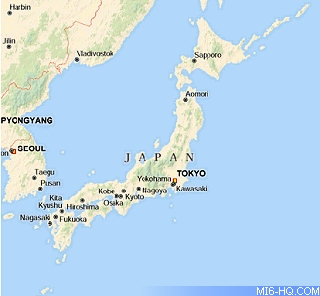 |
When we meet Bond at the beginning of You Only Live Twice
he has been in Japan for a full month with little apparent progress
in his mission. Charged with the apparently impossible task of
gaining access to top-secret Russian communications decrypted
by Japan’s Magic 44 code machine, he has been sent by M
in the hope that the mission will pull Bond out of the self-pity
that has engulfed him since Tracy’s murder in On Her
Majesty's Secret Service. Even by his own high standards
Bond is drinking too much, losing heavily in the casinos and has
been making careless mistakes in his work. He is now facing the
prospect of losing his previously cherished double-0 number.
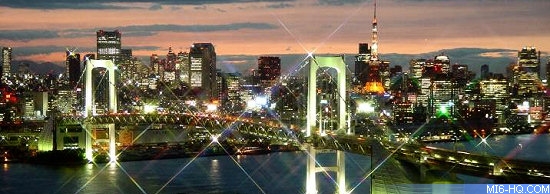 Above: The Tokyo skyline as it is
today - home to 32 million people
Above: The Tokyo skyline as it is
today - home to 32 million people |
When the 16th century feudal lord, Tokugawa Ieyasu, seized control
of the small fishing village of Edo, he had the ambitious aim
of making it the most powerful city in Japan. Amazingly enough
he surpassed this ambition and made it the biggest city in the
world through a rigidly controlled insular society that eventually
isolated Japan from the rest of the world. This isolation lasted
until 1867, when the US demanded trade access to Japan. Power
was handed to the Emperor, who made Edo his capital, which was
then renamed Tokyo and brought about rapid industrialisation to
enable Japan to catch up with the rest of the world. Following
the great earthquake of 1923 came the change of shopping customs
to Western style. Shoppers had left their shoes at the door in
traditional shops and the shopkeeper would bring goods for inspection
while the customer sat on a mat. The introduction of Western style
shops and department stores was much more time efficient and the
massive competition that this cultural change brought about saw
the introduction of the neon adverts that Japan is so much associated
with today. Following the obliteration of much of the city during
the Second World War, the American occupation coincided with the
rebuilding of the city to what it has become today.
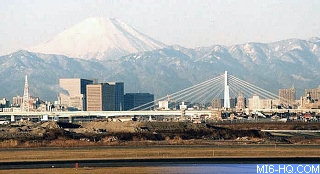
Above: Mount Fuji dominates the skyline
from the airport. |
|
Tokyo
Under the cover of working for Her Majesty's Australian
Diplomatic Corps, Bond is met at Tokyo airport by “Dikko”
Henderson. Henderson was based on the Sunday Times correspondent
for the Far East, Richard Hughes, a hard drinking Australian
ex-boxer who had showed Ian Fleming around Hong Kong and
then Japan, while “Tiger” Tanaka, head of the
Japanese Secret Service, was based on Torao Saito, Hughes’s
journalist friend who accompanied them while in Japan. |
Arriving from Hong Kong, Fleming was full of reservations about
Japan. In his own words “they had been bad enemies and many
of my friends had suffered at their hands”. However, “Richard
Hughes, who came with me in the Comet and who, being an Australian,
should have been predisposed against Japan, was totally enamoured
of it”.
| Although he put Bond in Hotel
Okura, next to the American Embassy in the heart of
the city, Fleming arrived in Tokyo amid “hordes of
American tourists attending the fashionable autumn or Chrysanthemum
Season, six hundred delegates for a G.A.T.T. conference
had descended on the town and Dick had finally had to accept
rooms in a Japanese inn”.
Although initially furious at having to put up with the
hardships of the inn, Fleming came to enjoy his stay at
the Fukudaya
Inn and even recommended it in “Thrilling Cities”,
his series of articles first published in the Sunday Times
and used the experience in You Only Live Twice
to describe Bond’s stay in a Japanese Inn.
Saito ensured that Fleming was kept entertained in full
Japanese style; in addition to a geisha house, he was taken
for a traditional Japanese massage, which seems to have
made quite an impact on Fleming - in chapter 9 (“Instant
Japan”) we read of Bond’s almost identical encounter,
with a “young girl, wearing nothing but tight, brief
shorts and a exiguous white brassière”. |
|
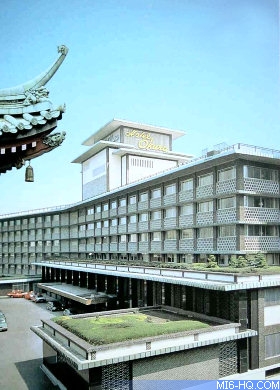
Above: The hotel Okura |
A month after first meeting Tiger in his headquarters (located
in the station of the then unfinished Tokyo Metro), Bond is invited
to a Geisha ceremony. Although there is often a misconception
that Geisha’s are prostitutes, Geisha’s entertain
by singing, dancing and providing witty conversation, as well
as performing the traditional Japanese tea ceremony, and we find
Bond and Tiger playing the children's game of Scissors cut Paper,
Paper wraps Stone, Stone blunts Scissors, while consuming vast
amounts of sake to the encouragement of the Geishas. After the
party Tiger gets down to business and by the end of the evening
the deal is done; for access to Magic 44 Bond must assassinate
the mysterious Dr Shatterhand.
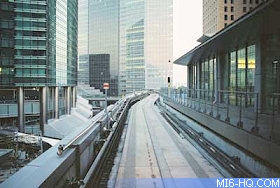
Above: The Tokyo Metro had not been
completed when Fleming wrote "You Only Live Twice". |
|
Departing from Tokyo main station on their
mission, Tiger explains to Bond that “we will take
the express to Gamagori, on the south coast and the evening
hydrofoil across Ise Bay to the fishing port of Toba. There
we will spend the night. This is to be a slow journey to
Fukuoka for the purpose of training and educating you. It
is necessary that I make you familiar with Japanese customs
and folkways so that you make as few mistakes as possible.”
By the time of their arrival in Toba, Bond had had enough
“and he was glad when he was at last left alone in
his maddeningly dainty room with the usual dainty pot of
tea, dainty cup and dainty sweetmeat wrapped in rice-paper”.
|
That evening Bond and Tiger dine on the ghoulish house speciality
“a large lobster whose head and tail had been left as a
dainty ornament to the sliced pink flesh in the centre. Bond set
to with his chopsticks. He was surprised to find that the flesh
was raw. He was even more surprised when the head of his lobster
began moving off his dish and, with questing antennae and scrabbling
feet, tottered off across the table. ‘Good God, Tiger!’
Bond said, aghast. ‘The damn thing’s alive!’”
The Japanese hunger for raw fish is well known, but as well as
eating live lobster, one 2,000 year old delicacy involves pinning
down a live fish, removing the skin which is chopped, seasoned
and replaced on the still live fish. What is indefensible about
these dishes is that the purpose of both is to provide a barbaric
spectacle of suffering, rather than to guarantee the freshness
of the animal. A rather more appetising meal follows an episode
where Bond feeds a bottle of beer to a cow and then, taking a
mouthful of shochu (a Japanese spirit that can be distilled from
ingredients as diverse as potatoes, sugar, rice or barley) to
spray over its back, gives the cow a massage. The result of this
special treatment (“the herdsman was greatly impressed by
your sincere performance with his cow”) is the highly prized
Kobe beef, which was “without equal in Bond’s experience.”
Following the meal, Bond is taken to a ninja training school
run by the Japanese secret service, where he is shown some of
their skills, such as scaling walls and fighting, as well as a
display of ninja weapons. The ninja, or “stealers in”,
were spies and assassins said to be able to make themselves invisible
in the 16th and 17th centuries. After the ninja training school
James Bond was exhausted. “To Bond’s unspeakable relief,
they put up that night at the smartest hotel in Kyoto, the Miyako.
The comfortable bed, air-conditioning and Western-style lavatory
on which one could actually sit were out of this world”.
Bond makes the most of his stay at the Miyako,
which first opened its doors in 1900, and orders “a pint
of Jack Daniels and a double portion of eggs Benedict” and
the next day Tiger takes a hung-over Bond to tour “the oldest
whore-house in Japan” before driving to Osaka and taking
a ferry across the inland sea to Kyushu. It is on board the ferry
while eating ham omelettes that Tiger introduces Bond to the haiku,
the Japanese verse of seventeen syllables, and one of its leading
exponents, Basho. Asked to write a haiku for himself
Bond spends a few minutes with pen and paper before unveiling
his effort:
| |
“You only
live twice:
Once when you are born
And once when you look death in the face” |
|
|
Beppu
Arriving in Beppu (on Kyushu, the third largest island in Japan
and the birthplace of Japanese civilisation), we are treated to
another glimpse of the geysers and fumaroles of the spa town before
progressing to another traditional Japanese meal; the fugu
feast.
The fugu is the Japanese blowfish that has the ability
to inflate its body to many times its normal size and project
protective spikes. Inflated and dried, they are sometimes used
as lanterns, particularly outside fugu restaurants. Some
of the fish’s organs contain tetrodotoxin, 1,200 times more
deadly than cyanide and a pinprick of it can kill. As a result,
fugu chefs must be specially licensed to prepare the fish, which
produces a numbness of the lips due to trace amounts of the poison
remaining. Nearly 100 people die every year from fugu
poisoning, mainly because they have prepared it themselves, and
preparation is so specialised that the fish costs up to $200 per
head. One more curious fact – it is the only fish that can
close its eyes. “That’s just what I would have chosen
for dinner”, jests Bond when learning of its properties,
but the “very thinly sliced and rather transparent white
fish” served raw “tasted of nothing, not even of fish”.
| The following morning the two are collected
in a police car and driven to the headquarters of the Sosaka
(the CID equivalent) in Fukuoka where he is briefed on Dr
Shatterhand’s castle and its garden of death. Wondering
how he will gain access he learns that “there is an
Ama island called Kuro only half a mile out to sea.”
Although an island called Kuro exists, it is more than 10
miles out to sea and appears to have no history of the Ama,
a gypsy like tribe whose girls traditional dive with only
a loincloth. Famous for pearl diving, Ama divers originally
dived for food, such as seaweed and shellfish and on Fleming’s
imaginary Kuro they dive for awabi shells. Awabi
are a type of abalone, a shellfish related to the sea snail,
and rare due to being over-harvested. |
|
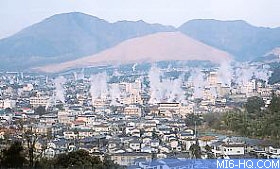
Above: The Beppu skyline |
Bond stays on Kuro as a guest of the family of Kissy Suzuki,
a local girl who had made a film in Hollywood. He plans to spend
the two days until full moon with the family before making his
way to the castle at night, returning to the island once the mission
is complete. Each day Bond rows Kissy out with her pet cormorant
(named David after the actor David Niven, the only person who
had shown her any respect while in Hollywood) and must pull Kissy
up from the depths when she tugs on a rope.
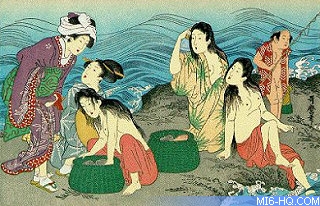
Above: Japanese Ama divers
|
|
On her first dive Bond is surprised to
see the bird appear with a catch of its own and watches
as “with a contemptuous glance, the cormorant tossed
the fish into the floating tub and disappeared like a black
bullet”.
Enjoying the plain, simple life of the Ama in contrast
to “the dark dirty life he had chosen for himself”
Bond thinks ahead to his mission: “Today and the next
would be stolen days, days with only Kissy and the boat
and the bird and the sea. He must see to it that they were
happy days”.
|
"The World Of James Bond" will continue next month...
Article by David Leigh.